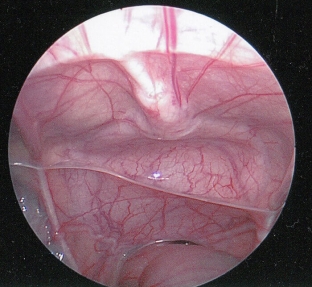During fetal development, the bladder is connected to the amniotic fluid. The urachus serves as the embryonic urinary duct. This is a tubular formation that normally heals by the 6th month of pregnancy, while forming the median umbilical ligament. At birth, at the site of the urachus, an obliterated bandless cord is determined, which stretches from the top of the bladder to the navel between the transverse fascia and the peritoneum. When obliteration does not occur by the time of birth, pathological processes can develop in it. How is an urachus cyst formed and manifested?
What is an urachus cyst? Characteristics of pathology
At complete cleft, a vesicle is formed – umbilical fistula. If the proximal and distal ends are obliterated with non-closure of the middle section, a urachus cyst is formed. If the paravesical region is not closed, then a diverticulum of the bladder is formed.
Characteristics of the urachus cyst:
- Urachus cyst contains serous exudate, mucus, meconium and urine.
- The cyst may not grow in size or cause pain for a long time.
- Urachus cyst is dangerous due to the risk of suppuration and the development of sepsis.
- Pathology in men is much more common.
- Urachus cysts can be as large as a man's fist.
- In most cases, the cavity of the cyst is closed, but sometimes it can communicate with the external environment or with the bladder through a thin fistulous tract. In this case, urine is expelled through the navel.
Urachus cyst symptoms. What is the danger of pathology?
Small cysts that have sterile contents are not accompanied by clinical symptoms and are not detected during clinical examination. When an urachus cyst becomes infected, symptoms develop purulently – inflammatory process. Enlargement of the cyst leads to squeezing of the bladder, which is accompanied by flatulence, constipation and dysuric disorders. What is the danger of this pathology, read further on estet-portal.com. The complicated course of the urachus cyst is characterized by fever, reddening of the skin under the navel, abdominal pain, pain and swelling of the abdominal wall.
The danger of urachus cysts is that a festering cyst can break into the abdominal cavity, bladder with the development of peritonitis or bladder fistula.
Umbilical fistula contributes to the periodic release of pus from the paraumbilical orifice with skin irritation, the development of omphalitis, which is not treatable. When straining during physical exertion, the amount of pus released from the umbilical opening increases.
Diagnostics and treatment of urachus cysts
On palpation of the abdomen, a large cyst can be detected. It is palpable in the form of a rounded formation, which is located between the navel and the pubis. At the time of diagnosis, it is important to distinguish a urachus cyst from a bladder diverticulum, a hernia of the anterior abdominal wall, or an umbilical cyst. After the inflammatory process subsides, fistulography is performed to determine the communication of the unoccluded urinary duct with the bladder.

Perforation or suppuration of the urachus cyst is accompanied by a clinical picture of an acute abdomen. A definitive diagnosis can only be made by diagnostic laparoscopy or laparotomy.
Surgical treatment of urachus cysts. When abscessing requires urgent opening and drainage of the abscess cavity, then a standard operation is performed.







Add a comment